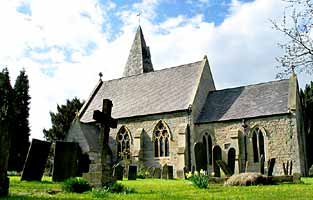For this church:    |
 GonalstonSt LaurenceNewark Archdeaconry Newark and Southwell Deanery IntroductionThere has been a church in the village of Gonalston, Nottinghamshire since at least the thirteenth century. Documentary evidence records the presence of a priest named Richard Durium in 1269, and the fact that in 1289 the church was in need of repair. Little is left of the early fabric of the building but the chancel walls are original, dating from the late 12th or early 13th century. The church houses three stone coffin lids with medieval carved effigies, plus the redundant bowl of a Norman font and a pillar stoup. Two piscinas can also be seen, one in the chancel the other in the exterior northern face of the chancel wall. This provides evidence of a known diminution of the church in 1787. The entire nave and the west tower were rebuilt in 1853 by local architect Thomas Chambers Hine. Within the tower are two bells dating from 1684, plus two dating from 1852. The churchyard is still in use as a burial ground with grave markers including iron-railed family plots, plus both slate and stone markers dating back to the early 18th century. Only one of the church windows is fully glazed with stained glass, but parts of the windows in the north aisle contain small areas of old glass depicting the armourial insignia of the de-Heriz and other families who were Lords of the Manor from the 12th century. A small but decorative War Memorial is also sited in the north aisle. Gonalston is a parish almost in a time capsule in that the population peaked at only 134 in 1851 and in 2001 was only 100. It did however maintain its own priest until 1932 when it became a joint benefice with the neighbouring parish of Epperstone. Particular thanks to Doug Fletcher for research on this entry and for pictures |





